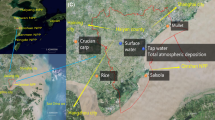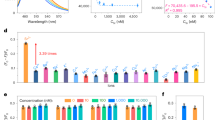Abstract
ONE of the main difficulties in estimating the integrated radiation dose which the population may receive from environmental contamination with strontium-90 has been to determine the average extent to which it enters food chains many years after deposition. Environmental surveys gave little information on this question in the earlier years of fallout from nuclear weapons tests as 90Sr directly retained on vegetation was then the main source of dietary contamination1. A more complete analysis was possible after 1966 when the reduced rate of fallout caused uptake from the soil to make the dominant contribution. The integrated total of 90Sr which will enter diet from a given deposition now appears to be about half that suspected a decade ago.
This is a preview of subscription content, access via your institution
Access options
Subscribe to this journal
Receive 51 print issues and online access
$199.00 per year
only $3.90 per issue
Buy this article
- Purchase on SpringerLink
- Instant access to full article PDF
Prices may be subject to local taxes which are calculated during checkout
Similar content being viewed by others
References
Russell, R. S., (ed.), Radioactivity and Human Diet (Pergamon Press, Oxford, 1966).
Medical Research Council, The Assessment of the Possible Radiation Risks to the Population from Environmental Contamination, HMSO, London (1966).
United Nations Scientific Committee on the Effects of Atomic Radiation, General Assembly, Official Records: Thirteenth Session, Suppl. No. 17 (A/3838) (United Nations, New York, 1958).
Russell, R. S., Nature, 182, 834 (1958).
Bartlett, B. O., Burton, J. D., Ellis, F. B., and Mercer, E. R., Agric. Res. Counc. Radiobiological Laboratory, Report ARCRL 10, 82 (1963).
Bartlett, B. O., and Russell, R. S., Nature, 209, 1062 (1966).
Cambray, R. S., Fisher, E. M., Brooks, W. L., and Peirson, D. H., UK Atomic Energy Authority Report AERE-R 6556 (1970).
Agric. Res. Counc. Letcombe Laboratory, Report ARCRL 20 (1970).
Russell, R. S., Bartlett, B. O., and Bruce, R. S., in Survival of Food Crops and Livestock in the Event of Nuclear War (Proc. Symp. Brookhaven Nat. Lab., 1970) (edit. by Bensen, D. W., and Sparrow, A. H.), US Atomic Energy Commission Symposium Series, 24, 548 (1971).
Bartlett, B. O., Agric. Res. Counc. Letcombe Laboratory, Annual Report, 1970, 26 (1971).
United Nations Scientific Committee on the Effects of Atomic Radiation, General Assembly, Official Records: Twenty-fourth Session, Suppf. No. 13 (A/7613) (United Nations, New York, 1969).
United Nations Scientific Committee on the Effects of Atomic Radiation, General Assembly, Official Records: Seventeenth Session, Suppf. No. 16 (A/5216) (United Nations, New York, 1962).
United Nations Scientific Committee on the Effects of Atomic Radiation, General Assembly, Official Records: Nineteenth Session, Suppf. No. 14 (A/5814) (United Nations, New York, 1964).
United Nations Scientific Committee on the Effects of Atomic Radiation, General Assembly, Official Records: Twenty-first Session, Suppf. No. 14 (A/6314) (United Nations, New York, 1966).
Van der Stricht, E., Gaglione, P., and de Bortoli, M., Health Physics, 21, 217 (1971).
Bennett, B. G., US Atomic Energy Commission Report HASL-246, 107 (1972).
Author information
Authors and Affiliations
Rights and permissions
About this article
Cite this article
BARTLETT, B., RUSSELL, R. & JENKINS, W. Improved Relationship between the Deposition of Strontium-90 and the Contamination of Milk in the United Kingdom. Nature 238, 46–48 (1972). https://doi.org/10.1038/238046a0
Received:
Revised:
Issue date:
DOI: https://doi.org/10.1038/238046a0
This article is cited by
-
Control of mRNA processing and decay in prokaryotes
Genetica (1994)
-
Regulation of nitrogenase messenger RNA synthesis and stability in Klebsiella pneumoniae
Archives of Microbiology (1981)
-
Rates of growth, ribosome synthesis and elongation factor synthesis in a tufA defective strain of E. coli
Molecular and General Genetics MGG (1981)



